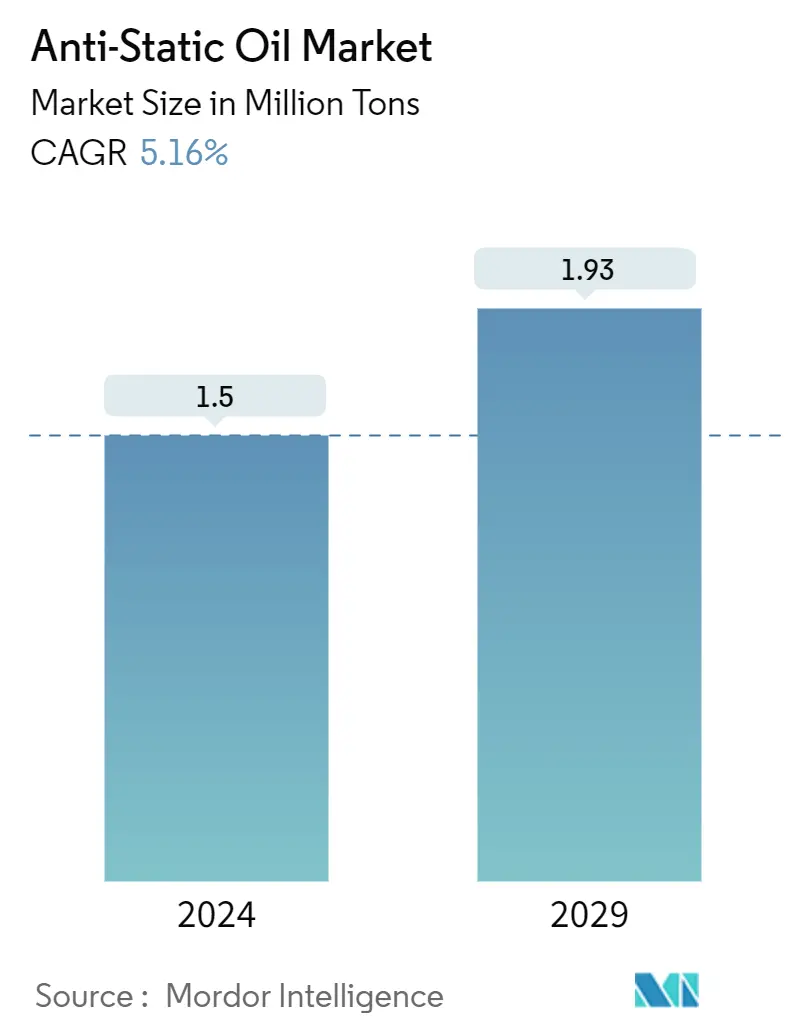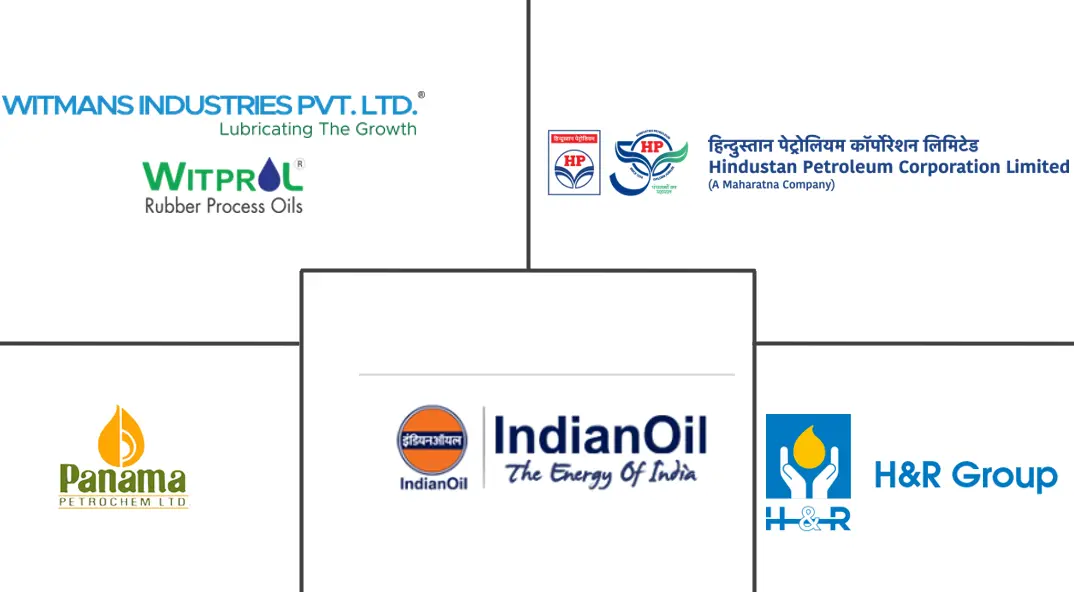Market Size of Anti-Static Oil Industry

| Study Period | 2019-2029 |
| Base Year For Estimation | 2023 |
| CAGR (2024 - 2029) | 5.16 % |
| Fastest Growing Market | Asia Pacific |
| Largest Market | Asia Pacific |
| Market Concentration | Low |
Major Players
*Disclaimer: Major Players sorted in no particular order |
Anti Static Oil Market Analysis
The Anti-Static Oil Market size is estimated at 1.5 Million tons in 2024, and is expected to reach 1.93 Million tons by 2029, growing at a CAGR of 5.16% during the forecast period (2024-2029).
The COVID-19 pandemic had a mixed impact on the anti-static oil market. While it caused initial disruptions and setbacks, it also created new opportunities in specific sectors and accelerated the adoption of anti-static measures in some areas. The long-term impact is expected to be positive, with the market projected to regain its pre-pandemic growth trajectory in the coming years.
- Growing demand from key industries like textiles, aviation, and others is to be the prominent driver of the market.
- Fluctuating prices of raw materials such as mineral and vegetable oils create instability in the anti-static oil market.
- The advancement of spray-on and wipe-on application techniques can streamline processes and broaden the reach of the anti-static oil market.
- The Asia-Pacific region holds a dominant position in the global anti-static oils market, primarily due to major manufacturing hubs.
Anti Static Oil Industry Segmentation
Anti-static oil refers to a specialized type of oil formulated to reduce or eliminate static electricity on surfaces where it is applied. It is commonly used in various industries, especially in environments where static electricity can pose risks. It includes electronic manufacturing, chemical processing, and other sectors where static discharge might damage equipment or lead to hazardous situations. The oil helps dissipate built-up static charges, thereby preventing sparks or other related issues.
Product type, applications, and geography segment the anti-static oil market. By type, the market is segmented into temporary anti-static oil and permanent anti-static oil. By application, the market is segmented into the textile industry, electronics industry, automotive industry, aviation industry, and others (printing industry, food and beverage industry, and medical industry). The report also covers the market size and forecasts for the anti-static oil market in 15 countries across major regions. For each segment, the market sizing and forecasts are done on the basis of volume (Million tons).
| Applications | |
| Textile industry | |
| Electronics industry | |
| Automotive industry | |
| Aviation industry | |
| Others (Printing Industry, Food and Beverage Industry, and Medical Industry) |
| Product Type | |
| Temporary anti-static oil | |
| Permanent anti-static oil |
| Geography | |||||||||
| |||||||||
| |||||||||
| |||||||||
| |||||||||
|
Anti-Static Oil Market Size Summary
The anti-static oil market is poised for significant growth, driven by increasing demand from key industries such as textiles and aviation. The market is expected to recover from the mixed impacts of the COVID-19 pandemic, which initially caused disruptions but also spurred the adoption of anti-static measures. The Asia-Pacific region, with its robust manufacturing hubs, holds a dominant position in the global market. The advancement of application techniques like spray-on and wipe-on methods is anticipated to streamline processes and expand market reach. However, fluctuating raw material prices, including those of mineral and vegetable oils, pose challenges, creating instability in the market.
In the textile industry, anti-static oil plays a crucial role in enhancing loom efficiency by reducing friction and eliminating static electricity. The United States and the European Union are significant players in the global textile market, with substantial opportunities for investment and innovation. The demand for anti-static products is expected to rise, particularly in Asia-Pacific countries such as China, India, and Vietnam, where textile production and exports are on the rise. The market is partially fragmented, with major players including Witmans Group, Hansen & Rosenthal Group, Hindustan Petroleum Corporation Limited, Indian Oil Corporation Limited, and Panama Petrochem Ltd, among others.
Anti-Static Oil Market Size - Table of Contents
-
1. MARKET DYNAMICS
-
1.1 Drivers
-
1.1.1 Growing Demand From Key Industries Like Textile, Aviation, and Others
-
1.1.2 Other Drivers
-
-
1.2 Restraints
-
1.2.1 Fluctuations in the Prices of Raw Materials like Mineral and Vegetable Oils
-
1.2.2 Other Restraints
-
-
1.3 Industry Value Chain Analysis
-
1.4 Porter's Five Forces Analysis
-
1.4.1 Bargaining Power of Suppliers
-
1.4.2 Bargaining Power of Buyers
-
1.4.3 Threat of New Entrants
-
1.4.4 Threat of Substitute Products and Services
-
1.4.5 Degree of Competition
-
-
-
2. MARKET SEGMENTATION (Market Size in Volume)
-
2.1 Applications
-
2.1.1 Textile industry
-
2.1.2 Electronics industry
-
2.1.3 Automotive industry
-
2.1.4 Aviation industry
-
2.1.5 Others (Printing Industry, Food and Beverage Industry, and Medical Industry)
-
-
2.2 Product Type
-
2.2.1 Temporary anti-static oil
-
2.2.2 Permanent anti-static oil
-
-
2.3 Geography
-
2.3.1 Asia-Pacific
-
2.3.1.1 China
-
2.3.1.2 India
-
2.3.1.3 ASEAN Countries
-
2.3.1.4 Rest of Asia-Pacific
-
-
2.3.2 North America
-
2.3.2.1 United States
-
2.3.2.2 Canada
-
2.3.2.3 Mexico
-
-
2.3.3 Europe
-
2.3.3.1 Germany
-
2.3.3.2 United Kingdom
-
2.3.3.3 Spain
-
2.3.3.4 Italy
-
2.3.3.5 France
-
2.3.3.6 Turkey
-
2.3.3.7 Rest of the Europe
-
-
2.3.4 South America
-
2.3.4.1 Brazil
-
2.3.4.2 Argentina
-
2.3.4.3 Rest of South America
-
-
2.3.5 Middle-East and Africa
-
2.3.5.1 Egypt
-
2.3.5.2 Rest of Middle-East and Africa
-
-
-
Anti-Static Oil Market Size FAQs
How big is the Anti-Static Oil Market?
The Anti-Static Oil Market size is expected to reach 1.5 million tons in 2024 and grow at a CAGR of 5.16% to reach 1.93 million tons by 2029.
What is the current Anti-Static Oil Market size?
In 2024, the Anti-Static Oil Market size is expected to reach 1.5 million tons.

